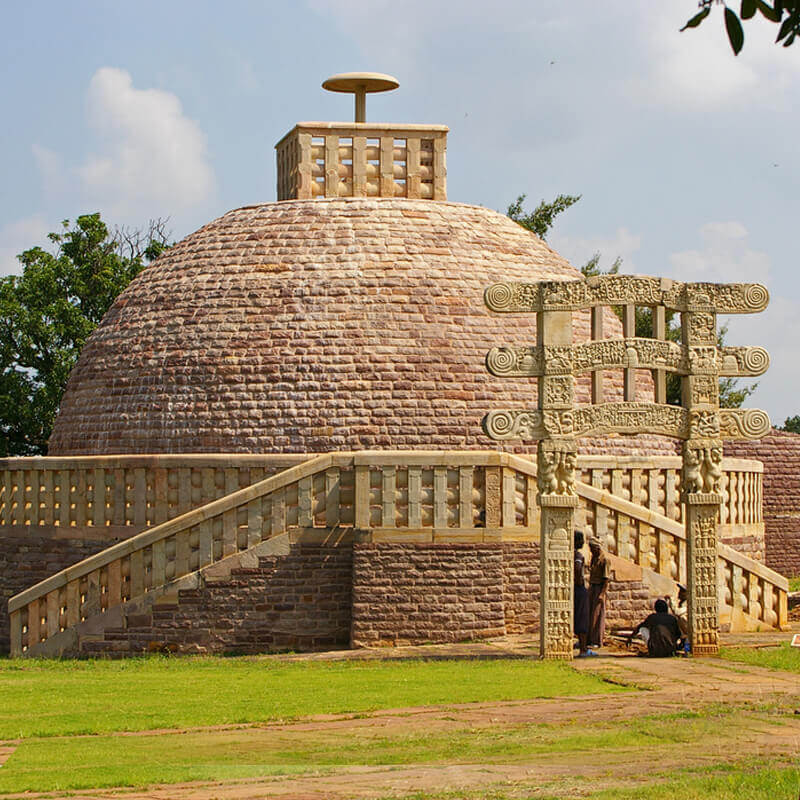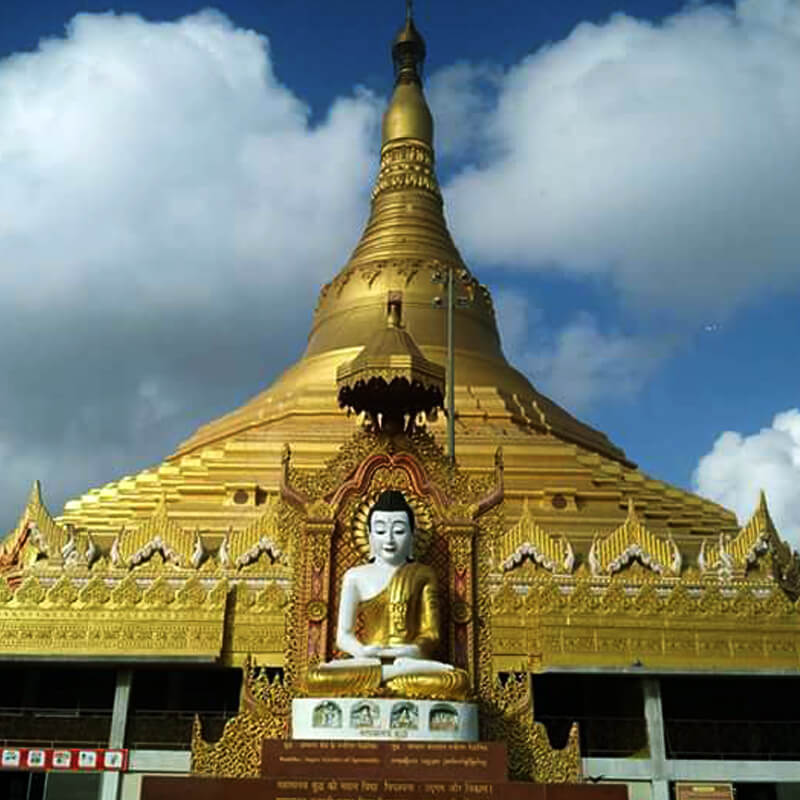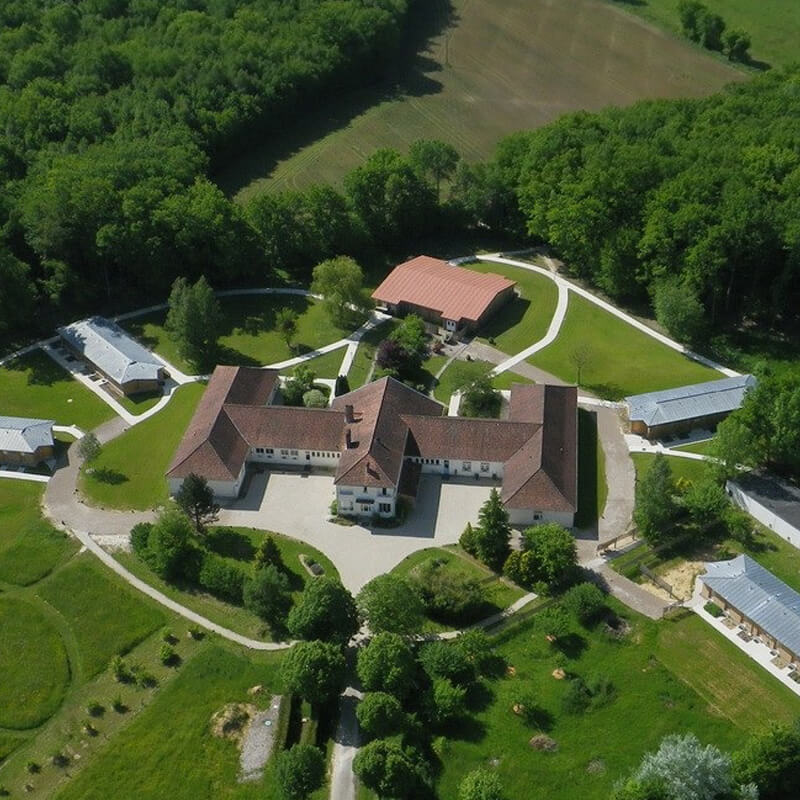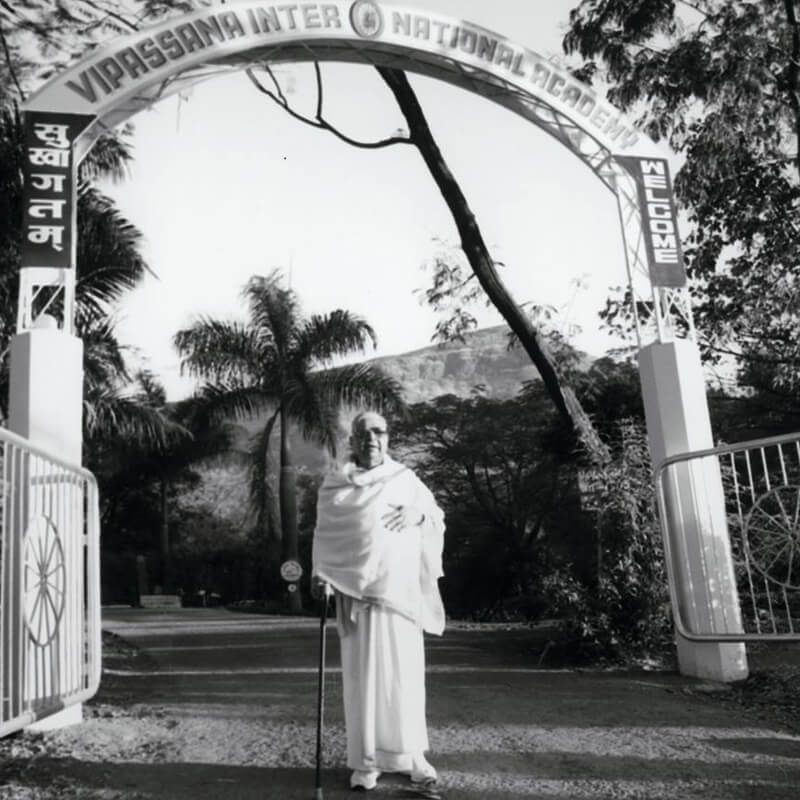June 26: The Dhamma Caravan took the ferry to the Swartz Bay BC Ferry Terminal on Vancouver Island. On arrival at Vancouver Island, the Dhamma Caravan drove to the Westbay Marine Village and RV Park. That same evening Goenkaji gave a public talk in Victoria at the Conservatory of Music in a magnificent stone church.
A group of Christian missionaries joined a Vipassana course a few years after Goenkaji started teaching in India. An elderly Mother Superior was part of this group. At the end of the course, she said, "Goenkaji, you are teaching Christianity in the name of the Buddha!" Goenkaji smiled and said that he taught the law of nature, which is the same for everyone. Misery is universal and the way out of misery is also universal.
June 27: Goenkaji decided to give Vipassana at the Victoria Truth Centre where a one-day course was being held. After giving Vipassana, he returned to the RV Park. He met a few meditators on his evening walk after which he gave two interviews on phone to journalists from Missoula, Montana. Then he gave an interview to Bennett Miller, the documentary filmmaker, travelling in the Dhamma Caravan.
June 28: The Dhamma Caravan took the 11:00 p.m. ferry back to the mainland. Travelling was slow because of rain and the heavy holiday-weekend traffic. Goenkaji reached the Po Lam nunnery of bhikkhunis from Hong Kong in Chilliwack at seven in the evening and was greeted by the nine bhikkhunis who lived there. The senior nun was an old student of Vipassana. The other nuns were planning to attend a ten-day course in Vipassana in September. Goenkaji presented books to the nuns. Since it was still raining, the Caravan decided to stop in a RV Park in Chilliwack.
June 29: The Dhamma Caravan left Chilliwack around 10:30 a.m. to travel to Dhamma Surabhi (Fragrance of Dhamma). Like the other centres visited by the caravan, the centre complex could not accommodate the students who had come for the scheduled one-day course, so tents were put up for use as temporary Dhamma hall and dining halls. When the caravan reached the center at 1:00 p.m., Goenkaji decided to go directly to the temporary Dhamma hall of the one-day course for a question-and-answer session. It was almost 2:00 p.m. when he finished answering questions from the students.
In the evening a free lance reporter recorded an interview with him for a radio station. Then he met students for private interviews. Later, the Vipassana teachers of Dhamma Surabhi took Goenkaji and Mataji on a tour of the building that houses all residences, kitchen, dining hall and meditation hall. They also showed him the plans for further expansion of the center. A brief meeting with the trust followed.
June 30: The natives of Canada before the European settlers came there are often referred to as the First Nations. The Grand Chief for the Cold Water people, his wife, daughter, and his father (an Elder for these people and an Elder with the Upper Nicola People) came to meet Goenkaji in the morning. The Grand Chief explained how his father and grandfather taught him a meditative life, how solitude has been important for him and how living peacefully with others is an important way of life for the people of the First Nations. Goenkaji explained how peace within puts us in perfect harmony with nature. He also explained how Vipassana cures various addictions and how it helps one come out of all defilements such as anger, hatred, and fear. He exhorted the visitors to try the technique so that they can have a better understanding of their own ancient culture and gain the strength to preserve it. He told the Chief how the Maoris in New Zealand have been benefiting from Vipassana.
Immediately after the meeting with the First Nations, a business reporter from the Chicago Tribune sought an interview on the phone. Goenkaji explained how Vipassana helps one to seek balance in life even when one is striving to excel in business. The reporter wanted to know what was wrong with charging money for Dharma teachings. Goenkaji replied that Dharma was priceless and putting a price-tag on it devalues Dharma. Moreover, when a Dharma teacher starts charging money for his teaching, it is no longer a selfless service out of love and compassion. There is a profit motive. This is fine in business but in Dharma it is a poison that kills the very essence of Dharma.
Goenkaji again gave some private interviews before winding up a long morning session. In the early evening he again met individual meditators. That evening, a ten-day course was starting at Dhamma Surabhi. The course was full. Goenkaji gave Anapana to the students from 9:00 to 10:00 p.m. The mettā session with Dhamma workers and some phone calls further detained him so that he could not retire to his motor home until after eleven.
July 1: Goenkaji's maiden visit to British Columbia generated much more interest in the general public than local meditators had expected. It also brought most of the local meditators together. It was inspiring to see so many people gathered to hear the profound and yet simple wisdom of Vipassana.
The Caravan left the Cold Water Valley in the morning. There were no events that day to push the Caravan to reach its destination. After a hectic program from San Diego to Dhamma Surabhi, the crew was able to sit back and relax a little bit. After passing through the Glacier National Park, Goenkaji was able to get down from his motor home to walk in the quiet cool mountain air. The Caravan reached Golden, a sleepy little town, at nine in the night.
July 2: The Caravan rolled out of the park around eleven in the morning and reached the KOA RV Park around six in the evening.
July 3: That weekend, Calgary was hosting their annual fair and rodeo show called the Calgary Stampede. Although most beings run in a stampede from birth to death, there are a few who do want to get out of this cycle of misery. A Vipassana meditator realizes that there is no greater stampede than the stampede of thoughts in the mind. In the morning a group of local meditators including trust members and assistant teachers came to the RV park to meet Goenkaji and ask him questions. Because one of the requirements for a long course is that one is either single or is in a committed relationship, one of the students asked what is a committed relationship. Goenkaji answered that a committed relationship means a lifelong commitment.
In the evening Goenkaji talked at the Metropolitan Centre in downtown Calgary. In anticipation of a large crowd, the organizers had made arrangements for a simultaneous telecast of Goenkaji's talk in an adjacent room for those who could not find a seat in the main hall. When it became clear that there would be an overflowing crowd, old students were asked to watch the talk next door, giving non-meditators the opportunity to listen to Goenkaji in the main hall.
Goenkaji explained that although this technique is commonly described as Vipassana meditation, meditation usually means concentration on a stationary object. Vipassana is different in that one observes the reality inside as it manifests itself from moment to moment, which is a constantly changing phenomenon. In this sense, Vipassana is unlike all other meditation techniques.
Calgary had recently hosted a Summit of G8 nations. In his talk, Goenkaji explained that there could not be peace in the world unless there is peace within each individual because society is made up of individuals. Goenkaji urged the audience to spare ten days to learn this wonderful technique. because intellectual understanding is for mere inspiration. Real results come only from actual practice. He said, "Practise Vipassana; see the results for yourself; and only then, accept it!"
After the talk Goenkaji gave an interview to Shaw TV. Afterwards, he met about 90 students from the SHAD program, in which some of the brightest high school students throughout Canada are brought together. It was encouraging that these bright intelligent teenagers had the opportunity to learn about Vipassana at such an early age.
July 4: It was a hectic day. The Caravan got ready early for its journey to Edmonton, the capital of Alberta (The Wild Rose Province). In the initial planning stages of the tour, there was some hesitation about including Edmonton on the tour as it meant that the Caravan would have to go northward from Calgary and then again go south to Calgary. However, the enthusiastic turnout of people at the evening public talk in the beautiful Edmonton City Hall showed that Edmonton merited a visit from Goenkaji. After the public talk, Goenkaji was interviewed for the TV show "Image India" by Mr Sharma.
July 5: In spite of the previous late night, Goenkaji was ready early the next morning for a talk to business people at the Telus Centre in the University of Alberta. The talk was co-sponsored by the Canadian Center for Social Entrepreneurship. Goenkaji told the audience that before he learned Vipassana, worldly success had made him very egocentric. He became very intolerant and angry as a result of this strong ego. He then explained how everything changed after he received the gift of Vipassana.
He remarked jokingly to a question that Dhamma is not a credit business, it is a cash business; one gets the results here and now. And one's credit also builds up as one accumulates good merits. Answering another question, he said that honesty is the best policy. However, greed makes one blind to one's own welfare. With Vipassana, one becomes soft inside, and yet, one can take tough actions whenever necessary.
He recited one of his favorite poems: It is easy enough to be pleasant When life flows along like a sweet song; But the man worthwhile is a man with a smile When everything goes dead wrong!
In the end, Goenkaji thanked the audience for sparing more than an hour to listen to him. He reminded them that the talk was only for intellectual understanding. To get the real benefit, they must spare ten days to learn this technique.
After the talk, Goenkaji and Mataji met the local meditators at a roadside rest area just outside Edmonton. Goenkaji answered their questions about their meditation practice, administrative matters, and the possibility of starting a new center. In the afternoon, the Caravan left Edmonton for a campground south of Calgary.
July 6: Goenkaji had a brief meeting with a local assistant teacher couple in the morning before the Caravan departed for the next destination back in the USA: a meditator's property near Whitefish, Montana.
July 7: In Missoula, the Caravan stayed on the property of a meditator's mother who had not only kindly allowed the Caravan the use of her property but had also offered the use of her house while she herself stayed away in a friend's house. All were touched by her gesture especially because of the inconvenience at her advanced age. All the newspapers in Missoula carried news of Goenkaji's arrival and articles on Vipassana. The Caravan had received a request from a prominent local TV news channel for an interview with Goenkaji. That night, local students gathered in the house to see Goenkaji on the ten o'clock news.
July 8: A tent was set up on the neighboring property of a local assistant teacher for meditators who had come for the one-day course. In the morning, Goenkaji gave Vipassana and also answered questions from the students. In the evening, he gave a public talk at the Music Recital Hall of the University of Montana. Goenkaji explained that the solution to the problem of misery can be found by the observation of mental impurities. Breath and sensations are intimately connected to mental defilements-they are two sides of the same coin. Therefore, one can observe breath or sensations and thus face the mental impurities and eradicate them.
July 9: In the morning, Goenkaji gave an interview on the phone to Minnesota Public Radio. He explained that the basis of any unwholesome vocal and physical action is an unwholesome mental action. And for every mental action there is sensation on the body at the same time.
The interviewer was curious to know about Vipassana courses for business executives and for prisoners. This day was the first of three long travel days. The Caravan set out just before eleven in the morning and made an uneventful journey through the vast plains of Montana to a motor home park in Billings.
July 10: When Goenkaji and Mataji learned that there was some likelihood of delay, they decided not to stop for tea. Thus the Caravan could travel continuously and reach its destination by 8:00 p.m.
July 11: The Caravan had to reach the next destination in time because the campsite closes its doors at 9:00 p.m. Goenkaji was briefed about correspondence on the road. He gave instructions and clarifications in response to questions from all over the world about administrative issues as well as questions about meditation. All the vehicles reached their destination almost at the same time. The local meditators came with food for Goenkaji and Mataji as well as the crew. That evening Goenkaji and Mataji had the opportunity to walk at their leisure for the first time in three days.
July 12: The twin cities of St. Paul and Minneapolis have a close-knit group of Dhamma workers who have been serving on non-center courses in the area for years. They took the opportunity of Goenkaji's presence in their area to gather at the campground and seek his guidance on various matters related to meditation and Dhamma service. They wanted to know whether they were ready for a Vipassana center. Goenkaji encouraged them to find a suitable place for a center or at least for a Dhamma house that could be converted into a full-fledged center in the future.
In the evening, Goenkaji gave a public talk at the Ted Mann Concert Hall at the University of Minnesota. He described how trying to fulfil craving (taṇhā) is like trying to fill a bottomless bucket. Goenkaji emphasized the experience of impermanence (anicca) at the level of sensations as the way to come out of all misery. When one develops awareness of sensations, their characteristic of anicca becomes obvious. This experiential wisdom of anicca leads to the next logical step of the understanding of suffering. That which is impermanent cannot be the cause of lasting happiness. And that which is impermanent and suffering cannot be regarded as "I" or "mine".
Goenkaji explained that non-self (anatta) is not a philosophical statement about the presence or absence of "soul" but the truth of the mind-matter phenomenon that one refers to as "I" or "mine". With the practice of Vipassana, one realizes how this entire phenomenon is ephemeral and essenceless. It keeps on changing all the time. One has no control over it.
Experiential wisdom of anatta is the logical conclusion of the understanding of anicca. The more one gets established in the experiential wisdom of anicca the closer one gets to the wisdom of anatta.
July 13: Goenkaji left early to go to the one-day course. On his evening walk, Goenkaji gave instructions on the formation of a new trust for Vipassana in prisons of North America. As Vipassana is proving its efficacy in American prisons and hence gaining more acceptability, a need was felt to have a separate organization for Vipassana activities in prisons. Donations from other charitable organizations will be accepted by this trust because inmates are usually not in a position to give donations. Goenkaji has made this policy specifically for North America where assistant teachers and Dhamma workers have to travel by air. Creating necessary facilities and providing food is also expensive. The courses themselves will be offered free of charge. Goenkaji made it clear that in keeping with principles laid down by him, he does not want the assistant teachers and Dhamma workers involved in this activity to receive any money other than out-of-pocket expenses such as travel expenses.
July 14: Once again Goenkaji had to hurry in the morning to get to the venue of his first talk in the Chicago area. The talk was at the Hindu Temple of Greater Chicago. He had planned to speak in Hindi but because of a large number of expatriates from South India in the audience, he was requested to speak in English.
He told the audience that he was brought up in a devout Hindu tradition where he learned to recite the Gita at an early age. The part of Gita that appealed to him the most was the ideal of sthitaprajna (one established in wisdom). He often gave lectures on Gita and about sthitaprajna-vītarāgabhayakrodhah etc. He recounted his frustrations at finding himself not getting any closer to the ideal in spite of all his devotion and tearful prayers. After he took a Vipassana course, he felt that the ideal was now within his reach. Anyone who walks on it had the potential to become a sthitaprajna.
It was after two in the afternoon when Goenkaji finished his lunch. The caravan had to travel to another campground closer to Chicago and then to the Field Museum, the venue of the public talk that evening. As soon as it reached the campground, Goenkaji had to leave for the evening talk at the James Simpson Theatre, Field Museum.
Goenkaji emphasized that Vipassana is not a devotional or emotional game. It is not an exercise to quench the thirst of intellectual curiosity but a serious undertaking to face mental impurities and eradicate all misery. It takes continuous hard work. A ten-day residential Vipassana course is designed to offer a conducive atmosphere for this crucial task.
July 15: Goenkaji went to the Arya Samaj site, where a one-day course was organized. Three teachers from the crew went with a local meditator to look for a suitable site for a prospective Vipassana center in Chicago.
July 16: Goenkaji met the families who were cooking food for the members of the Dhamma Caravan and looking after their other needs. Goenkaji visited a Myanmar monastery in Chicago in the evening. The hall was packed with people and they spilled outdoors where a few speakers were set up. In his informal talk, Goenkaji explained how the Buddha taught nothing but sīla, samādhi and paññā.
The Buddha defines his teaching as:
“sabbapāpassa akaranaṃ, kusalassa upasampadā; sacittapariyodapanaṃ, etaṃ buddhāna sāsanaṃ. Abstain from unwholesome deeds, perform wholesome deeds, purify the mind-this is the teaching of the Buddhas.”
Goenkaji explained that pariyodapanaṃ means purification of the totality of the mind. It is easy to calm the surface of the mind. But whenever the sleeping volcanoes of impurities (anusaya kilesa) from the depth of the mind arise, one reacts in the same deleterious manner and continues the cycle of misery. The anusaya kilesa are eradicated only when one works at the level of sensations.
At the end of the talk, someone asked a question about Buddhist philosophy. Before replying to the question, Goenkaji said that the term "Buddhist philosophy" is a contradiction in terms. Buddha was above all philosophies, above all theories and speculations because he understood and experienced the truth in its totality. What he taught was not based merely on speculative reasoning. One proposes theories (unsubstantiated hypotheses) when one doesn't know the truth. The Buddha discovered the truth, and therefore, what he taught was neither a theory nor a philosophy. It is the Law-it operates independent of even the Buddha.
Goenkaji then expressed his gratitude to his motherland for the invaluable jewel of Dhamma.
(to be continued)






